Parícutin
| Parícutin | |
|---|---|
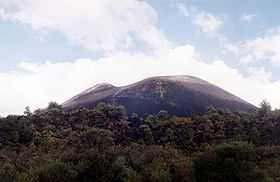 Parícutin in 1994 | |
| Elevation | 2,800 m (9,186 ft)[1] |
| Prominence | 208 m (682 ft)[2] |
| Location | |
| Location | Uruapan Municipality, Michoacán, Mexico |
| Coordinates | 19°29′34.8″N 102°15′3.6″W / 19.493000°N 102.251000°WCoordinates: 19°29′34.8″N 102°15′3.6″W / 19.493000°N 102.251000°W |
| Geology | |
| Type | Cinder cone |
| Age of rock | 1941-1952 |
| Volcanic arc/belt | Trans-Mexican Volcanic Belt |
| Last eruption | 1952 |
| Climbing | |
| First ascent | 1943 |
| Easiest route | Hike |
Parícutin (or Volcán de Parícutin, also accented Paricutín) is a cinder cone volcano in the Mexican state of Michoacán, close to a lava-covered village of the same name. The volcano is unique in the fact that its evolution from creation to extinction was witnessed, observed and studied by human beings. It appears on many versions of the Seven Natural Wonders of the World. Parícutin is part of the Michoacán-Guanajuato volcanic field, which covers much of west central Mexico. It is part of the Ring of Fire.
History
Three weeks before the actual eruption, rumbling noises that resembled thunder were heard by people near Parícutin village. These were actually deep earthquakes.[3] The volcano began as a fissure in a cornfield owned by a P'urhépecha farmer, Dionisio Pulido, on February 20, 1943. He and his wife witnessed the initial eruption of ash and stones first-hand: "Dionisio Pulido and his wife Paula were burning shrubbery in their cornfield."[3] The volcano grew quickly, reaching five stories tall in just a week, and it could be seen from afar in a month. Much of the volcano's growth occurred during its first year, while it was still in the explosive pyroclastic phase. The nearby villages Parícutin (after which the volcano was named) and San Juan Parangaricutiro were both buried in lava and ash; the residents relocated to vacant land nearby.
At the end of this phase, after roughly one year, the volcano had grown 336 metres (1,102 feet) tall. For the next eight years the volcano continued erupting, although this was dominated by relatively quiet eruptions of lava that scorched the surrounding 25 square kilometres (9.7 square miles; 6,200 acres) of land.[4] The volcano's activity slowly declined during this period until the last six months of the eruption, during which violent and explosive activity was frequent. In 1952, the eruption ended and Parícutin went quiet, attaining a final height of 424 metres (1,391 feet) above the cornfield where it began. The volcano has been quiet since then. Like most cinder cones, Parícutin is believed to be a monogenetic volcano, which means that once it has finished erupting, it will never erupt again. Any new eruptions in a monogenetic volcanic field will erupt in a new location.
Volcanism is a common part of the Mexican landscape. Parícutin is merely the youngest of more than 1,400 volcanic vents that exists in the Trans-Mexican Volcanic Belt and North America. Three people died as a result of lightning strikes caused by the eruptions, but no deaths were attributed to the lava nor asphyxiation.[4]
Shots of the volcano during its active phase were included in 20th Century Fox's film Captain from Castile, released in 1947.
Gallery
-
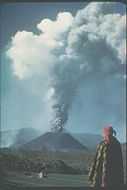
Cinder cone in 1943
-
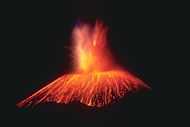
1943 eruption
-
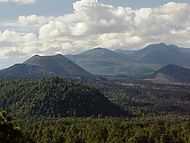
Parícutin from Las Cabañas
-
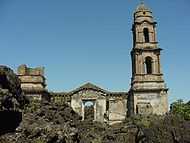
San Juan Parangaricutiro Church
See also
Notes
- ↑ "Elevaciones principales - Michoacán de Ocampo" (in Spanish). Instituto Nacional de Estadística y Geografía. 2005. Retrieved 2012-02-04.
- ↑ SRTM data
- ↑ 3.0 3.1 "The eruption of Parícutin (1943-1952)". How Volcanoes Work. Retrieved 2012-02-04.
- ↑ 4.0 4.1 "Parícutin, Mexico". Volcano World. Retrieved 2012-02-04.
References
- Luhr, James F.; Simkin, Tom, eds. (1993). Parícutin: The Volcano Born in a Mexican Cornfield. Geoscience Press. ISBN 978-0-945005-14-8.
- "Parícutin: The Birth of A Volcano". The Smithsonian Institution.
External links
| Wikimedia Commons has media related to Paricutin. |